The fascinating history of the Muir-Hill tractor
Posted by Chris Graham on 24th January 2023
Jonathan Whitlam introduces the first Muir-Hill tractor that built on the concepts of the Northrop 5004 and made them truly successful.

Muir-Hill tractor: The 101 was a very distinctive tractor with its bright yellow paint, square, no-nonsense bonnet lines and generous ground clearance. It was based on the Ford 5000 but fitted with a Ford 2703E 5.9-litre industrial engine producing 108hp. Performance was very impressive with near perfect weight distribution resulting in plenty of traction.
The idea of a large, four-wheel-drive tractor using a centre-drive propshaft with a high ground clearance was originated by Chaseside engineer David Brown, who wished to produce a machine that could be used for agricultural tasks while also, at the same time, be strong enough for forestry and sugar cane work. The result was the Northrop 5004, which was based on the Ford 5000 tractor and produced by Chaseside using the Northrop name, as we saw in Part 1 of this series.
However, Mr Brown left the firm not long after prototype testing of the new machine began in 1965, and went to join Muir-Hill. This firm, based in Gloucestershire, specialised in the manufacture of industrial and construction machinery, and had majored on dump trucks and loading shovels. It also had a long history of using Ford tractors as skid units for its machines. At that stage, though, the company hadn’t had much contact with agricultural machinery, with the exception of the Fordson Model N-based Powrcart dumper.
Nevertheless, Muir-Hill management obviously saw the appeal of a six-cylinder tractor that had all the benefits of the four-cylinder Northrop, but with more power output. It also recognised that such a machine could be used effectively for industrial tasks as well as in agriculture. So the green light was given for design work to begin and, in 1966, the Muir-Hill 101 was launched.

The rear end of the 101 came mostly from the Ford 5000, although it was beefed-up somewhat to cope with larger and heavier implements, and the extra power from the larger engine.
Muir-Hill 101
Four-wheel-drive tractors were gradually becoming more common on British farms during the mid-1960s, helped by the efforts of conversion specialists such as Roadless Traction and County Commercial Cars, which had both long used Ford tractors as the basis for their four-wheel-drive machines. County was the real specialist when it came to large, six-cylinder, equal-size-wheel conversions of the Ford 5000 tractor at that time, and it was models such as the Super-Six 954 that the Muir-Hill 101 would be going up against.
This was a tractor that used the Ford 5000 tinwork, albeit modified to house a 95hp Ford 2703E six-cylinder engine, and the same equal-size wheel design of earlier County machines. It also utilised twin-propshaft drive to the front axle, and featured the same ‘low build’ that gave the County tractors a very low centre of gravity, making them very stable on even steep gradients.
Roadless at this point, although offering a six-cylinder machine based on the 5000, concentrated on smaller-sized front wheels with a single propshaft drive, which kept its tractors looking very similar to the original Ford 5000 on which they were based.
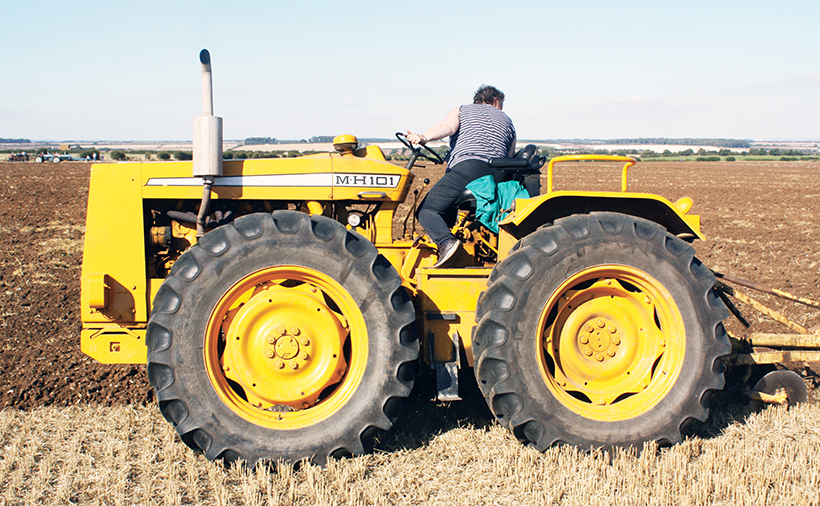
This view highlight the 101’s short wheelbase. A narrow step between the wheels helps the operator with access to and from the driving platform. The model featured a standard Ford eight-speed gearbox, with the control levers placed conventionally below the steering wheel. A drop box took the drive from the transmission then routed it equally to the front and rear axles.
When Muir-Hill launched the 101 in November 1966 however, this new machine looked very different to the other four-wheel-drive tractors. Despite still being based on the Ford 5000, the 101 had almost completely new tinwork instead of the Ford-derived bonnet, and was painted a bright yellow in keeping with the rest of the Muir-Hill line of industrial equipment. In addition to the striking colour, the Muir-Hill 101 also stood very tall, with much greater ground clearance under its belly; the centre line propshaft being positioned safely out of harm’s way, well within the chassis itself. The front axle was a clever design that allowed for a pretty tight turning circle for a tractor of such size, and much tighter than the County machines – the difference being so apparent it seemed the County needed half a field to turn around in comparison to the 101!
Under the skin the new 101 was very similar to the Northrop, except for the six-cylinder engine which Northrop then also adopted the following year. For the 101, Muir-Hill chose the six-cylinder Ford 2704E engine which was more powerful than the unit used in the County 954, producng 108hp. The Ford Motor Company did very good business at this time, not only selling its tractor skid units to converters and machine manufacturers, but also with its extensive range of industrial engines which were used in an untold number of machines and applications.
The Ford content on the 101 also included the standard 5000 dashboard and steering wheel, while the 5000 gearbox was also utilised, with the eight speeds giving a good range for most tasks. A transfer box behind the main ‘box split the drive between the rear and front axles equally, providing a very positive and reliable method of transmitting the engine’s power to the ground.
Other components, such as the rear hydraulics, were also taken from the Ford 5000, as was the power take-off set-up.
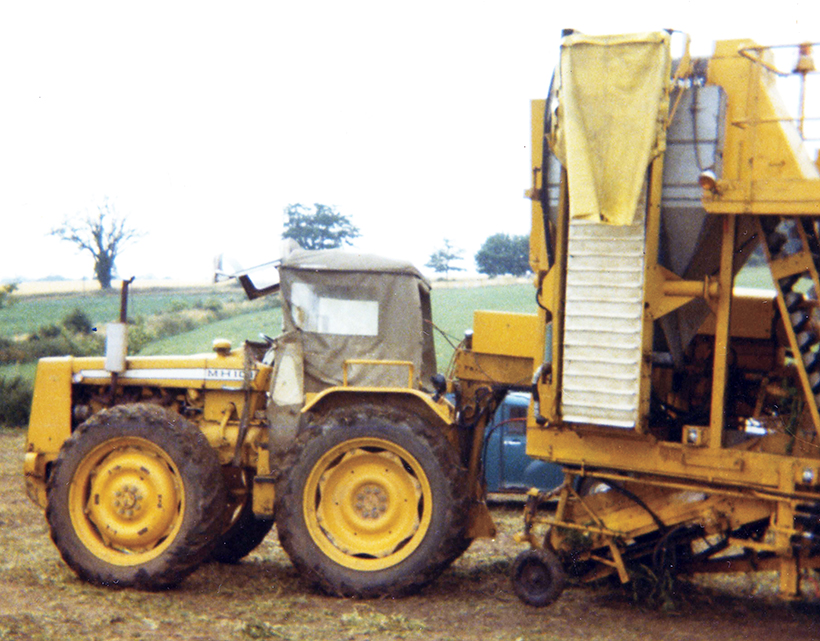
The over-engineered and very reliable front axle was designed and built by Muir-Hill, and was derived from that used on a new range of loading shovels introduced in 1965. This 101 was photographed in Norfolk during the 1970s, fitted with a Fritzmeyer weather cab complete with opening front section. This European-built cab was often specified for the 101 before the advent of a safety cab in 1970. (Pic: Paul Reeve)
The 101 on the farm
From the beginning, the 101 was also sold as an industrial power unit, designed to be used with a variety of heavy equipment such as large trailed dumpers and scraper boxes as well as winches, dozer blades and other equipment. However, the tractor also soon began selling in large numbers for use on British farms, with larger concerns finding the model ideal for heavy cultivation. Contrators, too, quickly came to appreciate how good the 101 was with constant, heavy workloads.
With plenty of weight over the front axle to maximise traction – especially when using mounted rear implements – the 101 also had the power to perform well when pulling very large ploughs and wide cultivators effortlessly in varying ground conditions. When the weather worsened, often it was only the Muir-Hill tractors that could carry on working, with two-wheel-drive machines soon losing traction.
Headland turns were easy thanks to the 101’s turning circle of only just over 16ft. This also made the Muir-Hill ideal for use on equipment such as sugar beet and potato harvesters in a wet season. In addition, the tractor’s high ground clearance was also a real plus point when being used to open-up rows of potatoes.
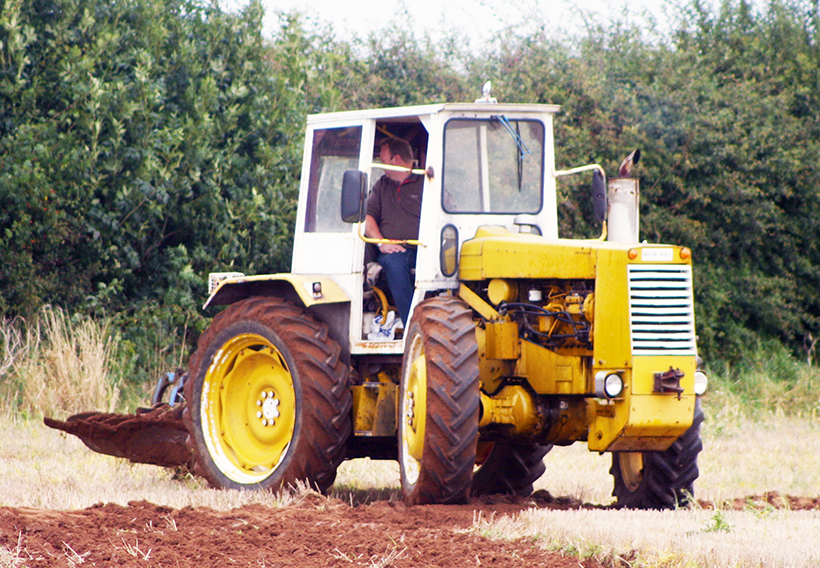
Some of the safety cabs were painted white, although most were yellow. This 101 demonstrates the excellent turning circle of its breed, as it manoeuvres on the headland while ploughing. Power-assisted steering was standard and definitely necessity!
Another task that the 101 was often called upon to do was the pulling of large and heavy trailed pea viners, such as those produced by Mather & Platt and FMC. These trailed machines had their own engines to drive their workings, but required a tractor to pull them across the fields as they collected the vines from the swaths left by pea cutters. While normal, two-wheel-drive tractors from the era – such as the Ford 5000 and Massey Ferguson 185 – could cope well enough with this sort of job when the ground was dry, it was a different story in the wet. Under those conditions it was the 101 that really came into its own.
What’s more, as the tractor pulling the viner had to straddle the swath of cut peas, the Muir-Hill’s extra ground clearance was also of great benefit. While Roadless and County tractors were also often employed pulling pea viners, and also coped just as well, the Muir-Hill 101 was often considered superior by viner drivers thanks to its lofty driving position and that excellent turning ability.
A second, lower-speed version of the Muir-Hill 101 was introduced during 1967. This was equipped with a reduction gearbox giving a total of 16 gear ratios and a minimum running speed of 0.075mph. This made the tractor ideal for a whole host of industrial tasks, as well as for use on drainage work with trench-digging machines that needed to be operated very slowly.
An after-market turbocharger was also offered by Colchester Tractors that, when fitted, boosted the power of the Ford engine to around 120hp. However, this doesn’t appear to have been a popular conversion, as few were done. Also, such work may have created a problem if the engine required subsequent attention under warranty; in those days, Ford was very wary if turbos were found to have been fitted to its engines.

The 101 received an upgrade in 1971, which included the introduction of the more powerful, 120hp, Ford 2715E six-cylinder engine. Despite this, the model’s ‘101’ number was retained as a new series of Muir-Hill tractors was waiting in the wings, to be launched in 1972.
Moving to Force
During 1968, Ford updated its tractor range with the introduction of the Force range, with improvements being made across the model range, including to the 5000. However, as most of the changes were to the four-cylinder engine, this didn’t affect production of the 101, which continued much as before, although the company ownership did change during that year.
Since 1959, Muir-Hill had been owned by Winget but, in 1968, the Winget concern and its Muir-Hill subsidiary was bought by Babcock & Wilcox Limited. This led to a few changes in paperwork terms, resulting in the creation of the renamed Muir-Hill Limited, and the tidying-up of the Muir-Hill range; loading shovels, dumpers, a new crane and, of course, the 101 tractor became the sole products of the newly-revised business. It was the industrial machinery that remained at the forefront for the new owners, but the company’s presence in the agricultural tractor market was about to increase as the tractor range was expanded.
In 1969, two new Muir-Hill tractors were unveiled, and these took the firm in a slightly different direction. They used Perkins diesel engines and the largest of the pair also happened to be the largest and most powerful tractor so far built in Britain. We shall meet these two new machines next time.
As for the 101, well it carried on as before, and remained the bestselling of the yellow tractors. It was upgraded in 1971, with the fitment of the Ford six-cylinder 2715E engine, boosting power output to 120hp. Despite this, the ‘101’ model name remained, although significant changes were just over the horizon. A new Series II range of Muir-Hill tractors arrived in 1972, and the 101 was replaced by the new 121.
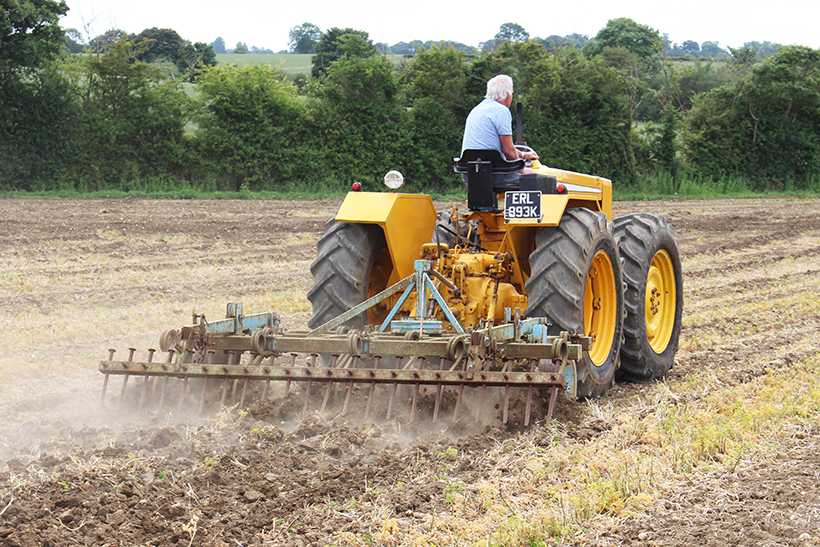
Ploughing and other primary cultivation tasks were the sort of work at which the 101 excelled. A three-furrow reversible plough was well within the tractor’s capability (many operators worked with larger implements) and, as seen here, cultivating could be tackled at quite a high speed thanks to the good spread of gear ratios within the Ford transmission.
Leading the legacy
Muir-Hill produced the 101 from 1966 to 1972 and, during those six years, the model established the company as a serious producer of agricultural tractors. Even though it used much the same components as rivals such as County, the 101 was different enough to appeal to many farmers and contractors that required a powerful tractor with superb traction and pulling ability, but also needed manoeuvrability and a decent turning circle.
Although based on the same original idea, the Muir-Hill 101 also triumphed where the Northrop 5004 had failed, probably mostly due to its more powerful six-cylinder engine. Northrop tried for too long to retain the original Ford 5000 four-cylinder engine and, when it finally produced the six-cylinder Northrop 5006, it was a case of too little, too late. The fact that it was rated at less than 100hp, compared with the 101’s 108, can’t have helped although, as things turned out, only one 5006 was ever sold before production ceased. Therefore, nobody can ever say for sure whether or not the Northrop 5006 would have been capable of challenging the 101.
Thanks to its success, though, the 101 saw Muir-Hill successfully move into producing a range of tractor models for both agriculture and industrial uses and, in the next article in this series, I shall be examining the first of these interesting machines; the 110 and the 161.
MUIR-HILL 101 BASIC SPECS
Engine: Ford 2703E (From 1971 Ford 2715E)
5.9-litre diesel
Power: 108hp (120hp from 1971)
Cylinders: 6
Transmission: 8×2 (from 1967 reduction
box version with 16 speeds)
Weight: 4,371kg
This feature comes from the latest issue of Ford & Fordson Tractors, and you can get a money-saving subscription to this magazine simply by clicking HERE
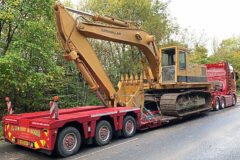
Previous Post
Classic Caterpillars on the move to a new home
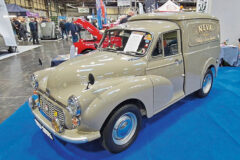
Next Post
Light commercials at the NEC’s Classic Motor Show



